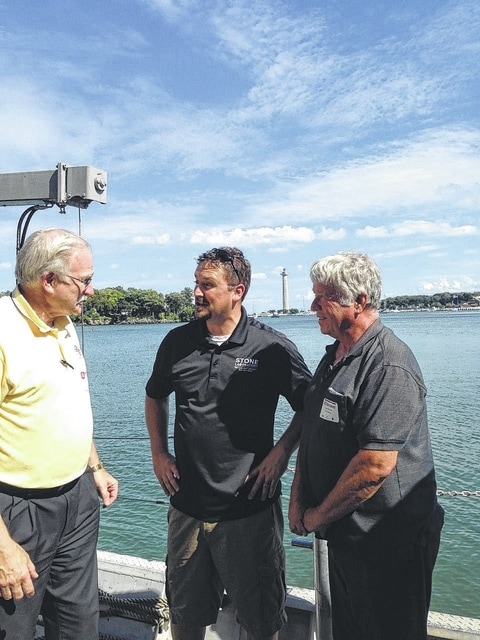
SIDNEY — Sidney Mayor Mike Barhorst and Third Ward Councilman Ed Hamaker traveled to the Franz Theodore Stone Laboratory on Aug. 25 to participate in Ohio Sea Grant’s ninth annual Lake Erie Day. The event is designed to update elected officials and decision makers on current critical issues affecting Lake Erie.
The Stone Laboratory is located on Gibraltar Island, near South Bass Island at Put-in Bay. The island is owned by The Ohio State University. Stone Laboratory is operated by the University.
While on the island, Barhorst and Hamaker had the opportunity to view the University’s facilities on Gibralter Island, including Cooke Castle, a National Historic Landmark and the former Put-in-Bay Fish Hatchery, which now serves as the Aquatic Visitors Center. They also had the opportunity to discuss key issues facing Lake Erie coastal communities including the current research, forecast and prevention efforts for harmful algal blooms and invasive species.
Barhorst and Hamaker joined the other participants on an afternoon cruise aboard one of Stone Laboratory’s research vessels during which water, plankton and invertebrate samples were collected. The participants then discussed the species collected.
Established in 1895, Stone Laboratory is the oldest freshwater biological field station in the United States and the center of The Ohio State University’s teaching and research on Lake Erie. The lab serves as a base for more than 65 researchers from 12 agencies and academic institutions, all working year-round to solve the most pressing problems facing the Great Lakes.
“Lake Erie is the eleventh largest lake on Earth by surface area,” Stone Laboratory Interim Director Dr. Chris Winslow told the group. “Of the five Laurentian Great Lakes, Lake Erie is the southernmost, the smallest by volume, the shallowest, and also the warmest. It is the most biologically productive, supporting the largest Great Lakes sport fishery.”
“Lake Erie has three distinct sub-basins: a very shallow western basin and related islands; a deeper central basin; an even deeper eastern basin that drains into the Niagara River and Lake Ontario. The lake provides drinking water to more than 11 million residents and supports a $1.5 billion sport fishing industry. Lake Erie is a vital resource for the binational Great Lakes region,” Winslow told participants.
“Eutrophication is a serious global problem that has re-emerged, resulting in harmful algal blooms in the western basin of Lake Erie, offshore anoxic zones — also known as dead zones — in the central basin, and nuisance levels of Cladophora in the eastern basin,” Winslow said. “All of these problems are linked to excessive loading of nutrients, particularly phosphorus.”
“The primary sources of phosphorus in Lake Erie are urban point and nonpoint sources, and agricultural nonpoint sources. Urban area loadings are associated with municipal and industrial facility point source discharges, combined sewer overflows as well as stormwater runoff containing nutrients from the land, including residential fertilizers. Agricultural nonpoint source pollution occurs primarily in the form of farm and field runoff, which results mainly from fertilizer and manure applications,” Winslow said.
Barhorst and Hamaker found the day to be educational and productive.
“I found it interesting that Ohio State’s collaborative research initiatives being conducted at Stone Laboratory will prove beneficial not only to aquatic life in Lake Erie,” Hamaker said upon his return, “but to the many communities surrounding the lake.”
“If the research being conducted on Gibraltar Island and elsewhere can truly reduce the amount of phosphorus in Lake Erie,” Barhorst said, “the same kinds of remedies can be applied to all of us who rely upon the waterways of our nation for drinking water, irrigation and recreational opportunities. The trip was certainly educational and worthwhile.”


